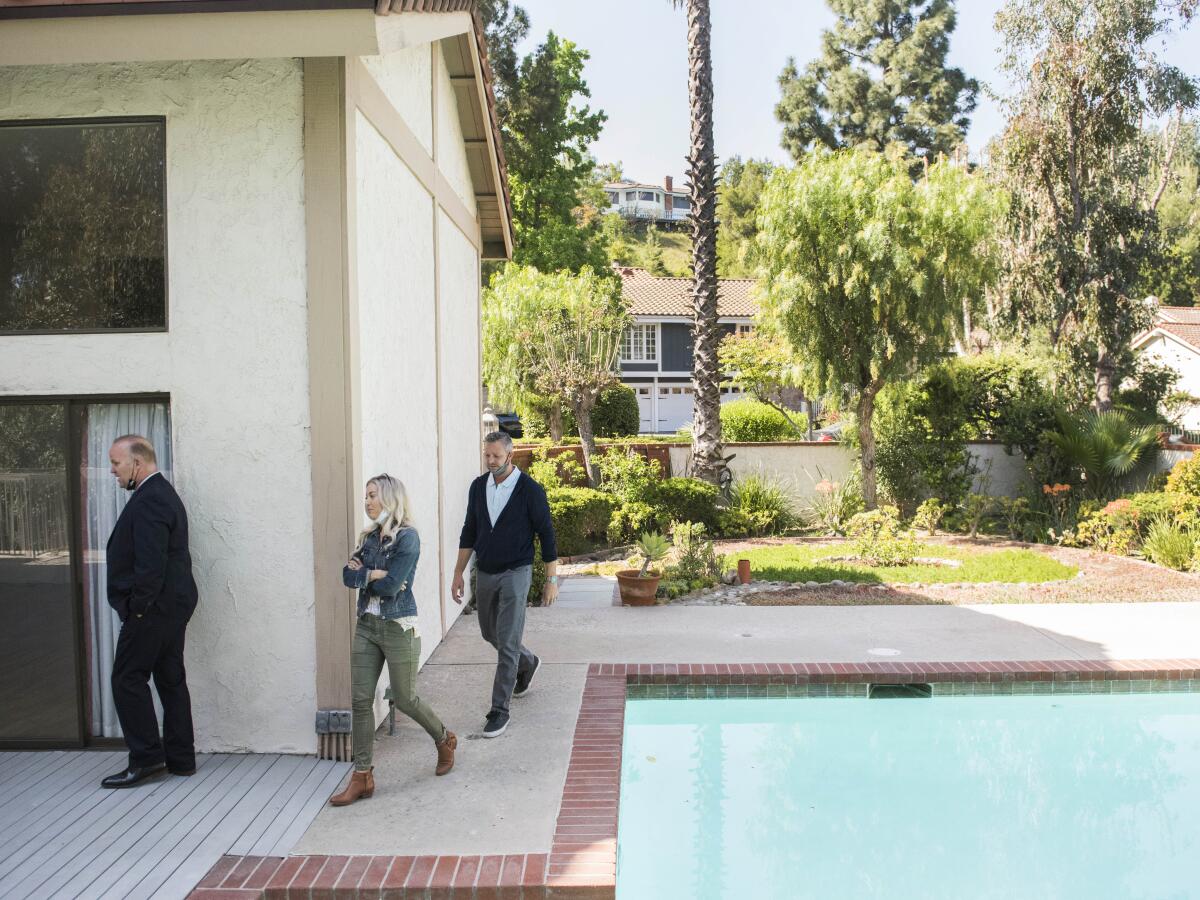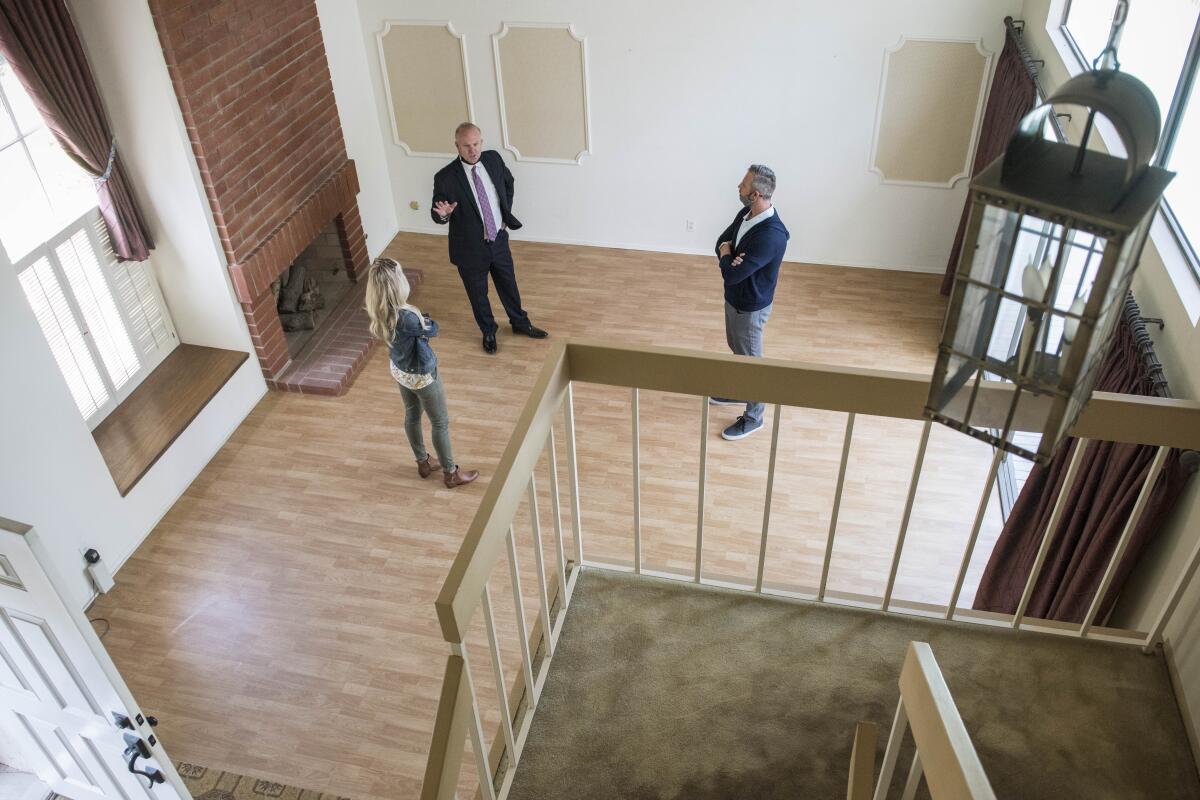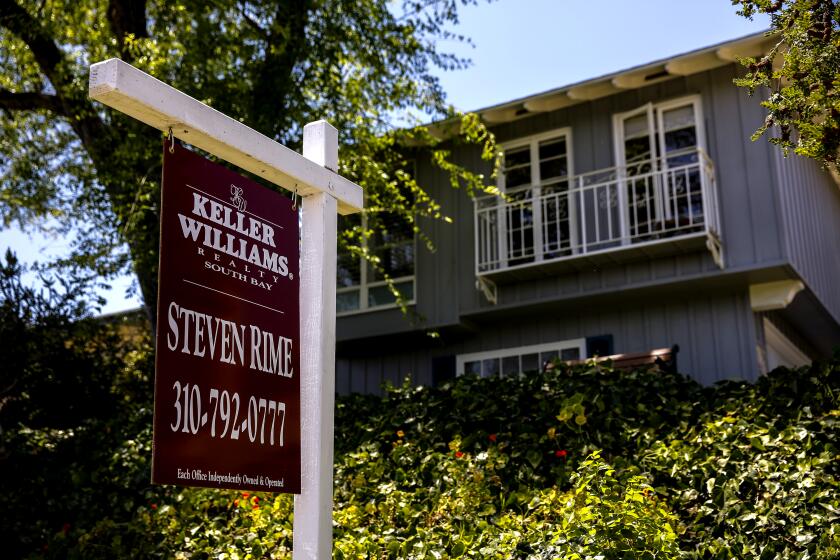Found your California dream home? Good luck with that â it may be gone by tomorrow

The four-bedroom house in North Tustin went on the market on a Thursday. That Saturday, Vik and Sarah Szemerei were inside, checking out the midcentury living room and debating how they could remodel the kitchen at the $1.1-million listing.
If they wanted to act, they didnât have much time; offers were due Tuesday.
Californiaâs housing market has been tight for years. But these are no regular times. Instead of the traditional open house where dozens of people flow in at their leisure and can stay for hours, pandemic rules limit showings to one group at a time.
The Szemereis had 30 minutes to tour the 2,092-square-foot home. They overstayed their slot by a bit, on the way out passing another couple awaiting their own timed tour. The Szemereisâ agent, Derek Oie, told them: Be aggressive. The property will have multiple offers.
âItâs almost like you speed date and then you are expected to marry someone,â said Vik Szemerei, 39, who put in an offer that weekend, one of a dozen that were submitted. âMy wife and I were like: On the one hand we will be so thrilled if we get it. And on the other hand, we are going to look at each other and say, âWhat did we just do?ââ
Homes are selling at warp speed nationwide, forcing would-be buyers to make snap decisions on what is typically the biggest purchase of their lives. In California, houses havenât sold faster in at least three decades, according to data from the stateâs main Realtors association.
In March, a homeâs median time on the market in the Golden State was eight days, the shortest time period recorded by the California Assn. of Realtors, whose database goes back to 1990. In the bubble years of 2003 to 2005, homes typically took more than 20 days to sell. In the hot-market years preceding the pandemic, the median time on the market at times dipped further, hitting a low of 14 days in 2017.
Few in the industry can remember a period when time on the market has been this short.
A combination of factors have collided during the pandemic to produce a market operating at a record pace, economists and real estate agents said. They include record-low mortgage rates, many people seeking out more space and a fresh influx of property investors. Making everything move even faster is how much of the home-buying process has moved online.
At the heart of todayâs snap buying is the cavernous gap between supply and demand, several experts said. The pandemicâs economic job losses mostly havenât touched the high-income earners most likely to buy homes, a cohort that is also saving more money now and seeking out larger homes. Millennials are also increasingly entering their early 30s, when people usually buy a home for the first time.
At the same time, structural changes are afoot that have enabled people to act more quickly if they want. Video tours of homes â either recorded or conducted live â have become more common during the pandemic, making people increasingly comfortable buying a home sight unseen, some experts said.
In March, slightly more than half of homes sold for over the asking price across Los Angeles. In some spots, the share was even bigger.
Compared with the bubble years of the early 2000s, listing websites such as Zillow and Redfin are now commonplace, allowing buyers to do research on homes the minute they hit the market and, in some cases, start an offer online.
Oie, the Chino Hills real estate agent representing the Szemereis, said such listing websites were shortening market time before the pandemic, allowing buyers to come to a viewing much more prepared and ready to bid. But he said heâs never seen people so willing to pull the trigger as quickly as these days.
In 30 years of work in the housing market, âthis is the only one where you have had buyers cramped upâ during a pandemic, he said. âNow, when they are getting to the point of buying a home â they are buying a home.â
Frenzied home buyers are breaking all sorts of records. Last year, 63% of people who bought a home nationwide placed an offer without seeing the property, according to a survey by brokerage company Redfin, an all-time high since the surveyâs debut in 2015.
Another Redfin survey found 43% of homes that were sold in the four weeks that ended April 11 fetched more than the list price, the highest since at least 2012.
South Bay real estate agent Garrison Comstock said he received 39 offers â about four times what he considered the high-water mark before the pandemic â on a three-bedroom house in Hawthorne that went into escrow for $116,000 over the asking price within six days of being listed.
Another agent, Lindsay Katz of Redfin, said her average sales pace is just two days.
In Southern California, the median home price has risen by double digits for eight consecutive months, reflecting how the intense competition for limited stock has sent prices soaring.
Another hallmark of pandemic-era home buying: To make their offers stand out, many buyers are waiving contingencies that allow them to back out of a deal without penalties if an appraisal doesnât come through or an inspection turns up a problem.
Szemerei said he and his wife arenât willing to relinquish those options, but they did bid over the asking price on the North Tustin house. They lost out to a bid that went $150,000 over. They viewed four more homes Friday.
âWe just scratch our heads as to where all these other buyers are coming from,â said Szemerei, a sales executive for a plumbing company.
Many are professional investors wielding cash, rather than someone who wants to call the property home, a trend that is partly driving the rapid sales pace, said Rick Palacios Jr., research director at John Burns Real Estate Consulting.
Many sellers will quickly accept a cash offer because it means they donât have to wait around to see if a loan comes through or not. And Palacios said large investment companies can get those offers out very quickly, employing algorithms that scrape listing websites for specific types of houses they want to buy and instantly devise an offer that fits their business model.
Recent research by the Irvine consulting firm found low yields globally are driving investor interest and money is pouring into single-family housing nationwide from pension funds, private equity groups and other institutional investors.
That trend was underway before the coronavirus hit, but the pandemic has also pushed investors to move money from retail and hospitality investments to single-family housing, the consulting firm said in a recent report. It considers a home an investor purchase if property tax documents are sent to a different address than the home being bought.
The regionâs median home price rose 15% in March, extending a pandemic-fueled housing boom. In L.A. County, the median price rose 17% to $750,000.
Still, while the number of investor sales is increasing across major markets nationwide, the overall investor share is declining, highlighting the sharp rise in demand from traditional buyers who are buying houses to live in.
In L.A. County, investor purchases made up 20% of the market in the last three months of 2020, compared with 21% a year earlier. There were similar declines in Orange County and the Inland Empire.
Volume-wise, the number of homes purchased by investors rose in most major U.S. markets during the fourth quarter, often by double-digit percentages, according to John Burns Real Estate Consulting.
In Southern California, investor sales jumped 34% from a year earlier in Ventura County, 25% in the Inland Empire, 13% in Orange County, and 12% in Los Angeles County.
Much of the investment flood is driven by companies seeking to rent out houses they own. But in the years before the pandemic, a new crop of companies launched and pitched themselves to traditional home sellers and buyers specifically on their transaction speed, leading analysts to call them instant buyers, or I-buyers.
Zillow and Redfin have launched their own I-buying programs, which like others will buy a home with cash, no viewings needed. Buyers simply type in their addresses online to get started. Once the home sells, the companies do any needed repairs and then sell, operating similarly to traditional flippers but on a platform that is accessible to the masses.
One I-buyer company, Opendoor, announced this month it is buying homes in Los Angeles, Orange and Ventura counties with a sales tag of up to $1.4 million, up from the previous limit of $900,000 and the $600,000 in 2019 when it first debuted in those markets.
The companyâs website advertises: âReady, set, sold. Get an offer in minutes, sell in a matter of days.â
Opendoor also offers buyers a service in which it purchases a house in cash for them, then later works to lock in mortgage financing.
On the supply side, the number of new listings is down, according to data from Zillow. In Los Angeles and Orange counties, there were nearly 9% fewer homes for sale in March than a year earlier.
Oscar Wei, deputy chief economist at the California Assn. of Realtors, said he believes the supply shortage is the main factor driving the record pace of home-buying. There were 67% fewer homes for sale in California last month compared with March 2004, amid the height of the real estate bubble, Realtor data show.

Some agents say people are still hesitant to sell and make a move during the pandemic out of health precaution; selling and moving entails a range of exposure to others and possibly COVID-19. Some of those who are prepared to move decided to stay put after seeing how hard it is to buy, contributing to the low supply.
âItâs a vicious cycle,â said Comstock, the South Bay agent who sold the Hawthorne house with 39 offers.
Builders are starting new projects, but it is notoriously difficult to add housing in California, particularly in the stateâs coastal areas. High lumber costs have also caused delays, according to the California Building Industry Assn.
Comparing time on the market across decades is tricky because there have been changes over the years in rules governing how agents may market a house before it officially hits the market. One reason that could be contributing to todayâs fast-selling market boils down to two words: âcoming soon.â
Some multiple listing services, which set certain ground rules for agents, have in the last year rolled out a status called âComing Soonâ that does not count toward time on market, said June Barlow, general counsel at the California Assn. of Realtors.
The label is allowing agents to build buzz with the general public before the homes officially âhitâ the market.
Art Carter, chief executive of the California Regional MLS, which covers wide swaths of Southern California, said agents are allowed to conduct some marketing on the house under the new designation and accept offers if they come in, but they arenât allowed to show it in person until the property becomes âactive.â
On Thursday afternoon, 349 âComing Soonâ homes in L.A. County were listed on Redfin.
âMost likely what you are getting ⌠is that people are ready to run with offers the second they can get into the house because itâs been out on these sites,â Carter said. Some sellers are accepting offers during âComing Soonâ periods as well, causing time on market to show up as one day, he said.
Palacios said the reasons specific to todayâs pandemic context might soon bring the speed of homes sales to an apex. But he also thinks there is a permanent shift underway that will keep homes selling quicker than they have historically: Big capital is sticking around, and even traditional buyers have become more comfortable with purchasing a home sight unseen, he said.
Itâs not only prospective buyers stressing out.
Tregg Rustad, a real estate agent focused on L.A.âs Westside neighborhoods, said some sellers start to panic when they donât get an offer on their house within five days â a seeming eternity in todayâs market.
âThey are like: âMy cousin, my brother and my sister-in-law â they are all telling me we should have 10 offers by now. Whatâs going on?ââ
More to Read
Inside the business of entertainment
The Wide Shot brings you news, analysis and insights on everything from streaming wars to production â and what it all means for the future.
You may occasionally receive promotional content from the Los Angeles Times.












